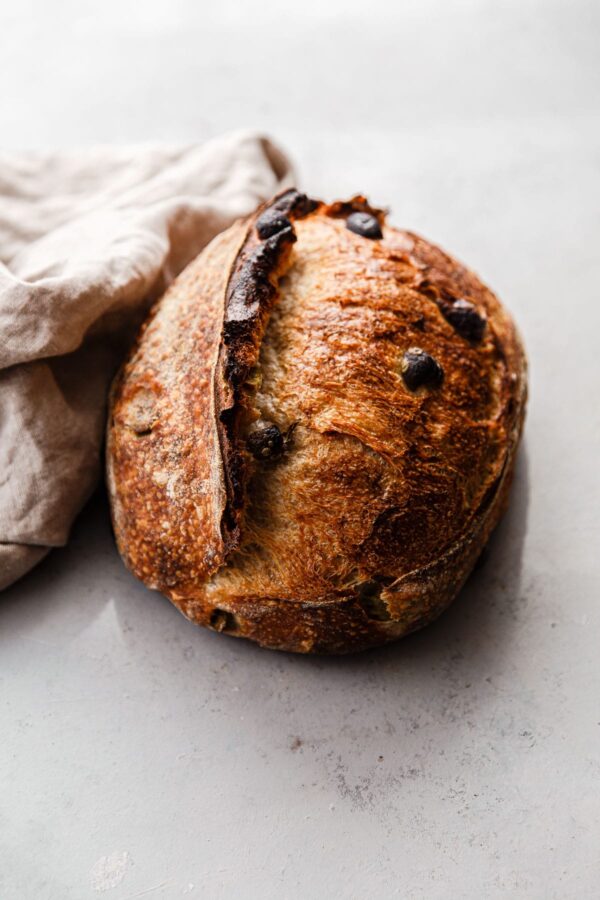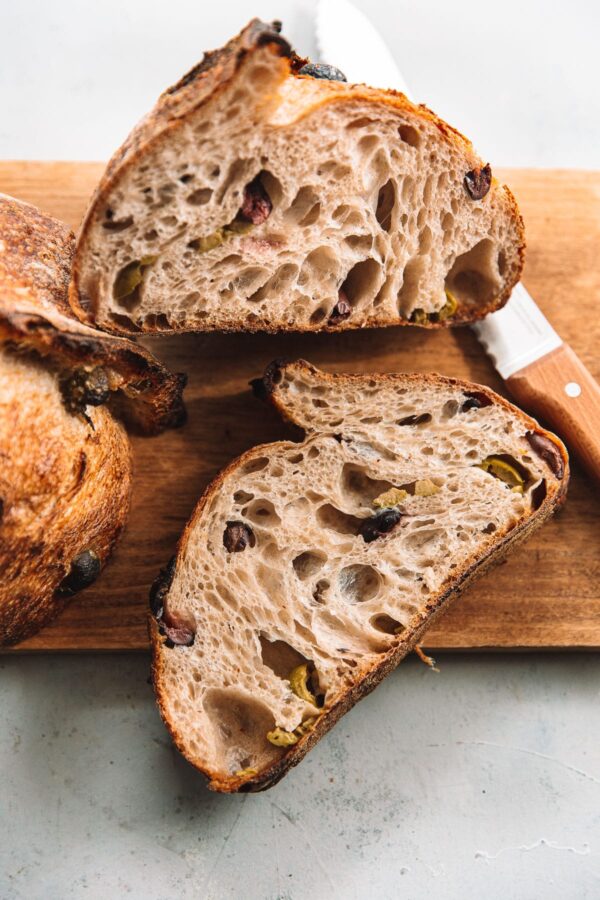Kalamata and Castelvetrano Olive Sourdough

This incredible olive sourdough bread is prepared with bread and whole wheat flour, and filled with two different types of olives, Kalamata and Castelvetrano olives for maximum flavor. It produces a dark and crusty artisan style open-crumb bread loaded with flavor. Serve with a high-quality extra virgin olive oil for dipping, slice thickly for grilling, or use for your favorite sandwiches.
Equipment
Ingredients
- 300 grams unbleached bread flour plus more for dusting
- 140 grams 90% extraction wheat flour or whole wheat flour
- 360 grams 90°F/32°C filtered water divided
- 90 grams ripe sourdough starter 100% hydration
- 9 grams Diamond Crystal kosher or fine sea salt
- 75 grams pitted Castelvetrano olives sliced in half
- 75 grams pitted Kalamata olives sliced in half
- white rice flour for dusting your banneton basket
Instructions
-
IMPORTANT NOTE: Many sourdough bread recipes call for preparing an off-shoot levain (eg. starter) for baking. I prefer to scale up and use a portion of my ripe, just peaked starter. This eliminates one extra step and works better for my normal feeding schedule and preferred baking timeline. This choice is up to you and can be tweaked/adapted to fit your schedule or starter feeding schedule, but please plan accordingly. Keep in mind that you’ll need to account for the starter quantity in this recipe (90 grams), as well as the normal quantity needed to continue to maintain and feed your starter.
-
Autolyse: In a large mixing bowl, combine 300 grams unbleached bread flour and 140 grams 90% extraction wheat or whole wheat flour. Add 350 grams (90°F/32°C) filtered water and mix with your hands until thoroughly combined and no dry bits are visible. Cover with a clean shower cap or plastic wrap, and rest at 78°F/25.5°C for 1 hour and 30 minutes. This step hydrates the flours and helps build dough structure.
-
Add Starter and Rest: Add the remaining 10 grams filtered water and 90 grams ripe, just peaked sourdough starter. Use your fingertips to spread the starter over the autolyse mixture. Fold the edges of the dough into the center to fully incorporate the starter. Use your thumb and fingers to pinch the dough (pincer method) repeatedly until the starter is well incorporated. Don’t be delicate. You want to work quickly, but fully incorporate the mixture. Cover and rest at 78°F/25.5°C for 30 minutes.
-
Add Salt and Rest: Sprinkle 9 grams Diamond Crystal kosher or fine sea salt over the surface of the dough. Use your thumb and fingers to pinch and incorporate the salt thoroughly (you shouldn’t feel any granules at the end of mixing) into the dough. Depending on the coarseness of your salt, this might take several minutes. Be thorough. Cover and rest at 78°F/25.5°C for 15 minutes. Important Note and Tip: If you’re struggling with higher hydration doughs and dough strength, there are two additional mixing methods that can try: slap and fold or the Rubaud method.
-
Bulk Fermentation: We will preform 3 sets of stretch and folds in the first 45 minutes of bulk fermentation. These will take place in 15-minute intervals. Cover and rest the dough at 78°F/25.5°C between each set. The dough will not visibly rise during the stretch and fold period, but it should get considerably stronger. Dip your hands in water (to prevent sticking) before each fold. I like to rub my hands together to avoid incorporating much more water, as this is already a high hydration dough. How to Preform a Stretch and Fold: Grab the top portion of the dough with both hands. Gently pull and stretch it upwards (without tearing) and fold over the opposite edge. Rotate the bowl 180 degrees and repeat from the other side. Rotate the bowl 90 degree and repeat once again on both sides. This entire process is one stretch and fold set. After performing the stretch and folds, I like to gently lift the dough to round it nicely in the bowl (see video). *
-
Lamination (Adding the Olives): After preforming the third and final stretch and fold set, cover and allow the dough to rest at 78°F/25.5°C for 30 minutes. Lightly spritz your workspace with water (this will prevent the dough from sticking) – simply dip your hands in water and wipe the countertop lightly. Gently transfer and turn the dough out onto your workspace. Using both of your hands, gently grab and stretch the dough into a thin, large rectangular shape. The dough should be well developed and strong, and should be able to be stretch into a thin layer without tearing. Distribute the pitted and halved olive mixture across the surface of the dough.
-
At this point, we’ll fold the dough into an envelope. To do so, fold the dough by grabbing both the top and bottom edge of the left or right side, and gently folding it over until it reaches the center. Repeat from the other side, folding it over so that it overlaps the previous fold. Grab the top edges and fold them down, and repeat from the bottom edge. Flip the dough so that it is seam side down, and using your hands, gently and quickly shape it into a loose round. Transfer the dough back to the bowl, cover, and rest at 78°F/25.5°C. Note: Lamination helps add incredible strength to high-hydration loaves (with inclusions) and ensures equal distribution of add-in ingredients.
-
Bulk Fermentation (continued): After lamination, allow the dough to rest for roughly 45 minutes before proceeding. After 45 minutes, we’ll preform two coil folds (with a 30-minute rest period between each). How to Preform a Coil Fold: Lift the dough from the center using both hands, allowing both ends to stretch and release from the container, and then fold under. Rotate the bowl 90° degrees and repeat. Cover and rest the dough at 78°F/25.5°C between coil folds. After you have preformed the stretch and folds, allow the dough to rest, covered, at 78°F/25.5°C for an additional 1.5 – 2 hours, or until the dough feels lively, has a few surface bubbles, is rounded on the edges, jiggles slightly in the bowl, and has nearly doubled in size. Note: If the dough is very rounded in the bowl, feels very strong and is fighting you, you can skip these folds and simply allow the dough to rest for the remainder of bulk fermentation.
-
Pre-Shape: Carefully transfer the dough, without degassing, onto a clean countertop. Use a bench knife to gently shape the dough into a round, pulling it towards you on the countertop to create some surface tension. The key is to do this step as quickly and gently as possible. Rest the dough, uncovered, for 15 to 20 minutes, or until it has relaxed for the final shaping.
-
Final Shape: Dust a lined 10 or 11-inch oval banneton basket (or 9-inch round) with white rice flour (be extra liberal if you are not using a cloth or linen liner). Dust the surface of the dough lightly with bread flour. Use a bench knife to gently lift and flip it flour side down onto your countertop. Depending on your preference, banneton, or baking vessel, shape the dough into a round or batard
-
Final Proof: Place the covered banneton basket in the refrigerator and retard dough for 15-16 hours at 38°F/3°C. This slow and cold fermentation stage helps develop flavor and improves the final crust texture.
-
Preheat the Oven: Preheat your Challenger Pan, Dutch Oven, or combo cooker (with lid on) in a 500°F/260°C oven for at least 1 hour.
-
Transfer and Bake: If you are using a Challenger Pan or combo cooker, you can skip parchment (*I like to sprinkle a little semolina on the pan) and carefully invert the basket directly into the preheated base before scoring.Place a large piece of parchment over the banneton, then top with a thin cutting board. Invert and flip carefully, so that the banneton is upside down, setting it down onto your countertop. The dough should release, right side up, from the banneton onto the parchment. Trim any excess parchment paper, creating two handles on both ends for lifting the dough. Use a bread lame to score the dough (1/2-inch deep), carefully transfer into the preheated pan, cover tightly with the lid, and place in the oven. Bake covered at 500°F/260°C for 25 minutes.
-
Remove the lid. The dough should have risen and expanded considerably, and the crust should be set, but only lightly golden in color.
-
Reduce the oven temperature to 475°F/240°C (*note: if your oven runs hot or your loaves are browning too quickly, reduce the temperature to 450°F/232°C) and continue to bake uncovered for an additional 15-25 minutes or longer until the crust is deep golden and caramelized. I like to rotate the pan several times during this final stage to ensure even browning.
-
Carefully remove the bread from the pan and transfer to a cooling rack. Cool completely before slicing. This will take several hours. Slicing into warm bread will result in a gummier texture and cause the bread to stale faster.
Example Baking Timeline:
- DAY ONE:
- 8:00 AM – autolyse (mix flours and 350 grams water). allow mixture to rest, covered, at 78°F/25.5°C for 1 hour and 30 minutes.
- 9:30 AM – add remaining 10 grams water and sourdough starter, mix thoroughly. cover and rest at 78°F/25.5°C for 30 minutes.
- 10:00 AM – add salt and mix thoroughly. cover and rest at 78°F/25.5°C for 15 minutes.
- 10:15 AM – 10:45 AM – stretch and folds #1, #2, #3 (every 15 minutes). cover and rest at 78°F/25.5°C between each set.
- 11:15 AM – laminate the dough, layering in the olive mixture. cover and rest at 78°F/25.5°C.
- 12:00 PM -1:00 PM – preform two coil folds, 30 minutes apart, cover and rest the dough at 78°F/25.5°C between each set.
- 1:00 PM – 2:30 PM – allow to rest, covered, at 78°F/25.5°C for the rest of the bulk fermentation period. this period will range anywhere from 1.5 to 2 (or significantly longer), depending on ambient temperature, starter strength, and flour variety. follow the dough’s lead!
- 2:30 PM – pre-shape. leave uncovered at room temperature for 15 – 20 minutes.
- 2:45 PM – final shape. transfer to rice floured banneton basket, cover with a plastic bag, seal, and transfer to the refrigerator.
- 2:45 PM – 7:45 AM – retard dough (final proof) in refrigerator at 38°F/3°C for 15-18 hours.
- DAY TWO:
- 5:45 AM – preheat challenger pan, Dutch Oven, or combo cooker in 500F oven for at least 1 hour.
- 6:45 AM – remove banneton from fridge, transfer dough to preheated pan, score, and bake at 500°F/260°C, covered, for 25 minutes.
- 7:10 AM – remove pan lid, reduce oven temperature to 475°F/240°C, and bake uncovered for an additional 15 to 20 minutes or until deeply caramelized. allow loaf to cool completely (this will take several hours) before slicing.

